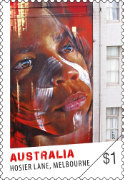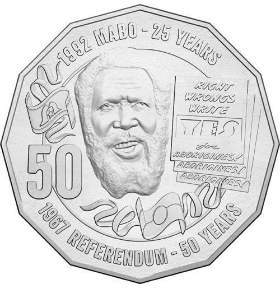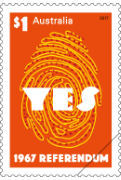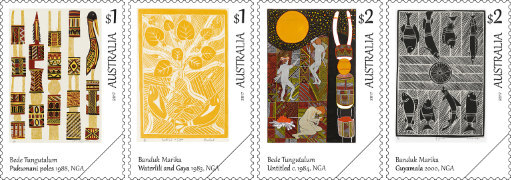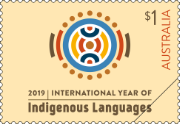Aboriginal timeline: Arts
Found 130 results for your search. Showing page 5 of 7.
2016
-
A new law in Victoria allows Koorie people to protect and control the use of their culture and heritage by nominating for protection particular elements, e.g. traditional songs, stories, dance and art with significant spiritual and cultural connection to knowledge.
-
Jessica Mauboy becomes the first Aboriginal lead actor in a drama series of a commercial network, starring as Billie Carter in The Secret Daughter by Channel Seven.
-
Rodney Kelly, a descendant of Cooman and leader of a delegation to secure the return of the historic ‘Gweagal shield’ from the British Museum, discovers a similar shield at the Ethnological Museum of Berlin. Both finds are significant and date from 1770 when the HMS Endeavour arrived at Botany Bay.
2017
-
NITV launches Australia’s first ever Aboriginal animated children’s series, Little J & Big Cuz.
-
Hip-hop duo A.B Original (Yorta Yorta man Briggs and Ngarrindjeri man Trials) win the Australian Music Prize (the biggest prize for an album in Australia) with Reclaim Australia.
-
Tracey Moffatt (Bedevil) represents Australia at the 57th Venice Biennale (13 May – 26 November), making her the first Aboriginal artist to present a solo exhibition at the event.
-

Artist Adnate is well known for his giant art works which often feature Aboriginal subjects. One stamp in Australia Post's Street Art issue shows artist Adnate’s large-scale work in Hosier Lane, Melbourne. The City of Melbourne commissioned this 23 metre mural of an Aboriginal boy in 2014. As in this portrait, Adnate’s subjects are often members of Aboriginal communities, and the artist has done a significant amount of fundraising work in this area.
-

The front side of the 50-cent coin shows Eddie Mabo's face, the Torres Strait Islander and Aboriginal flags and a 1967 referendum campaign poster. The Royal Australian Mint issues a special 50-cent coin, "Pride & Passion", to mark the 25th anniversary of the High Court Mabo decision and the 50th anniversary of the 1967 referendum. Artist and grand-daughter of Eddie Mabo, Boneta-Marie Mabo, helped with the design of the coin. Only 1.4 million coins are minted.
-

The stamp overlays two fingerprints and the iconic 'Yes' that marked the campaign. An Australia Post stamp commemorates the 50th anniversary of the 1967 referendum. On 27 May 1967, Australians voted to change the constitution to empower the federal government to make legislation for Aboriginal people, in the same way it could for all other Australians, and to include Aboriginal people in the census.
The stamp combines contemporary dot art elements and curved lines to form a symbol of two fingerprints merging to form one. The word "Yes" in the iconic referendum-campaign font symbolises strength in unity and what has been thus far achieved.
-
Since 1997 Australia Post celebrates living Australians who have positively shaped Australian society with its Australian Legends Award. In 2017 it honours three Aboriginal leaders: Tom Calma, Lowitja O’Donoghue and Galarrwuy Yunupingu for their tireless and lifelong efforts to improve social and economic outcomes for Aboriginal peoples. Together, their work has spanned the areas of land rights, economics, self-determination, health, welfare, education and reconciliation.
Since its inception, Australia Post announced the Australian Legends Award on Australia Day. Out of respect for those who associate 26 January with invasion and the colonisation of Aboriginal people, it scheduled this year's announcement to May, coinciding with the 50th anniversary of the 1967 referendum. [1]

Portraits of Aboriginal Elders Tom Calma, Lowitja O’Donoghue and Galarrwuy Yunupingu. -
A painting by Anangu artist Peter Mungkuri wins the inaugural Hadley's Art Prize, the world's richest landscape art prize at $100,000, beating 41 finalists. Mungkuri painted his birth place in Fregon, Central Australia, and called the painting Ngura Wiru, which means good country.
-
Josie Baker wins the title of Miss First Nation Ultimate Queen at the first Aboriginal and Torres Strait Islander national drag competition in Darwin.
-
Art of the North celebrates works by two eminent Aboriginal artists from the northern regions of Australia’s Northern Territory, Banduk Marika and Bede Tungutalum. The stamps show Pukumani Poles (1988), Waterlili and Gaya (1983), Untitled (c.1984) and Guyamala (2000).

The four stamps selected to represent Aboriginal art of the north of Australia. -
Australia Post publishes a set of stamps themed 'Art of the North', featuring works by two Aboriginal artists from the northern regions of Australia’s Northern Territory, Banduk Marika and Bede Tungutalum. All works are part of the collection of the National Gallery of Australia.

Left to right: Bede Tungutalum's Pukumani Poles, Banduk Marika's Waterlili and Gaya, Tungutalum's Untitled and Marika's Guyamala 2000.
2018
-
Ganalbingi man and artist Johnny Warrkatja Malibirr, from the remote community of Gapuwiyak in the Northern Territory, wins the inaugural Kestin Indigenous Illustrator Award.
-
Gurrumul’s final album Djarimirri (Child Of The Rainbow) becomes the first number one Australian Recording Industry Association (ARIA) album in an Aboriginal language, only a week after its release on 13 April. In August at the 2018 National Indigenous Music Awards it wins Album of the Year, Song of the Year for the title track, and Gurrumul is posthumously named Artist of the Year.
-
Gamilaroi woman Brooke Boney joins Channel Nine as the entertainment correspondent of the Today breakfast show to become one of the few Aboriginal faces on television. She was previously working for radio station Triple-J.
2019
-

The commemorative stamp design shows the official logo of the International Year of Indigenous Languages 2019. Australia Post issues a stamp commemorating the International Year of Indigenous Languages. There were at least 250 Aboriginal languages in Australia before invasion. Of the 120 or so languages that remain, about 100 are at risk of being lost. Only about 13 languages are alive as a first language spoken by the younger generation.
-
Yorta Yorta soprano Deborah Cheetham premières Eumeralla, a War Requiem for Peace, a performance sung entirely in the reclaimed Gunditjmara language, and sold out weeks in advance.
-
Spark Health, an Aboriginal merchandise business, launches a Change.org campaign to open the use of the Aboriginal flag to all Australians after WAM Clothing, the current licensing holder, sent a cease and desist notice to the business. By September 2020 more than 140,000 people had signed the petition.
References
View article sources (0)
[103865] 'The Australia Post Legends 2017: Indigenous leaders', Australia Post 29/5/2017
